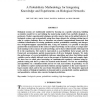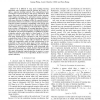325 search results - page 12 / 65 » Evolvable network architectures: what can we learn from biol... |
JCB
2006
13 years 8 months ago
2006
Biological systems are traditionally studied by focusing on a specific subsystem, building an intuitive model for it, and refining the model using results from carefully designed ...
BIBM
2008
IEEE
14 years 3 months ago
2008
IEEE
Identifying functionally important sites from biological sequences, formulated as a biological sequence labeling problem, has broad applications ranging from rational drug design ...
IJCNN
2006
IEEE
14 years 2 months ago
2006
IEEE
— It is difficult to map many existing learning algorithms onto biological networks because the former require a separate learning network. The computational basis of biological...
NEUROSCIENCE
2001
Springer
14 years 1 months ago
2001
Springer
This volume is intended to help advance the field of artificial neural networks along the lines of complexity present in animal brains. In particular, we are interested in examin...
ECCB
2005
IEEE
14 years 2 months ago
2005
IEEE
Many areas of modern biology are concerned with the management, storage, visualization, comparison, and analysis of networks. For instance, networks are used to model signal trans...


